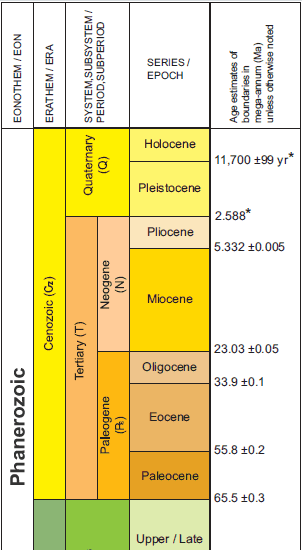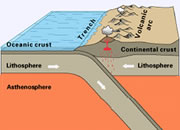
Geologic time scale with a linear time axis. This time scale is available as a printable .pdf document. You can download this printable time scale and make copies for personal use.
Dividing Earth History into Time Intervals
Geologists have divided Earth's history into a series of time intervals. These time intervals are not equal in length like the hours in a day. Instead the time intervals are variable in length. This is because geologic time is divided using significant events in the history of the Earth.
Examples of Boundary "Events"
For example, the boundary between the Permian and Triassic is marked by a global extinction in which a large percentage of Earth's plant and animal species were eliminated. Another example is the boundary between the Precambrian and the Paleozoic, which is marked by the first appearance of animals with hard parts.
Eons
Eons are the largest intervals of geologic time and are hundreds of millions of years in duration. In the time scale above you can see the Phanerozoic Eon is the most recent eon and began more than 500 million years ago.

Detailed geologic time scale: The United States Geological Survey has published "Divisions of Geologic Time: Major Chronostratigraphic and Geochronologic Units." It is a much more detailed time scale than the simplified scale shown above. View a copy here.
Eras
Eons are divided into smaller time intervals known as eras. In the time scale above you can see that the Phanerozoic is divided into three eras: Cenozoic, Mesozoic and Paleozoic. Very significant events in Earth's history are used to determine the boundaries of the eras.
Periods
Eras are subdivided into periods. The events that bound the periods are widespread in their extent but are not as significant as those which bound the eras. In the time scale above you can see that the Paleozoic is subdivided into the Permian, Pennsylvanian, Mississippian, Devonian, Silurian, Ordovician and Cambrian periods.
Epochs
Finer subdivisions of time are possible, and the periods of the Cenozoic are frequently subdivided into epochs. Subdivision of periods into epochs can be done only for the most recent portion of the geologic time scale. This is because older rocks have been buried deeply, intensely deformed and severely modified by long-term earth processes. As a result, the history contained within these rocks cannot be as clearly interpreted.
Our geologic time scale was constructed to visually show the duration of each time unit. This was done by making a linear time line on the left side of the time columns. Thicker units such as the Proterozoic were longer in duration than thinner units such as the Cenozoic. We also have a printable version of the Geologic Time Scale as a .pdf document. You can print this timescale for personal use.
Author: Hobart M. King, Ph.D.
| More Geologic Time Scale Resources |
|
Major Divisions of Geologic Time - US Geological Survey
Geologic Time Scale - Geological Society of America Geology Wing - University of California Berkeley Geologic Time Scale - University of California Berkeley |
| Printable Geologic Time Scale (PDF Document) |
| More Geology Topics |
 |
Gold |
 |
Fossils |
 |
Landslides |
 |
Plate Tectonics |
 |
Topo Maps |
 |
Metals |
 |
Gifts That Rock |
 |
General Geology |

Find Other Topics on Geology.com:

|

| ||

|

| ||

|

| ||

|

|
